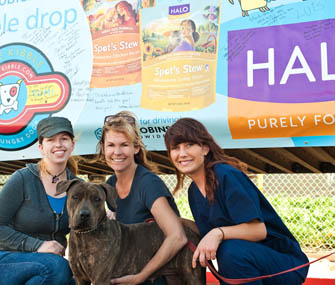Bordetella bronchiseptica is an easily contracted bacteria that causes a hacking cough or, occasionally, a snotty nose. Any pet can get the disease, and except in severe cases, a round of antibiotics is usually all that’s needed to treat it. In fact, many cases are mild and self-limiting enough that they require no treatment whatsoever. Vaccination can protect your dog from illness associated with Bordetella.
Summary
Bordetella bronchiseptica is a bacterium that is commonly associated with respiratory disease in dogs. It can also infect cats, rabbits, and, in rare cases, humans. It is one of the more common bacterial causes of canine infectious tracheobronchitis — also known as kennel cough.
Bordetella bronchiseptica is one of several organisms included on a short list of bacteria and viruses responsible for this kennel cough syndrome. Bordetella is highly contagious, easily transmitted through the air or direct contact, and resistant to destruction in the environment.
In healthy adult dogs, Bordetella usually causes no more than a mild, self-limiting illness. In puppies or in dogs with other underlying health issues, however, it can cause severe illness (such as pneumonia) or even death in rare cases.
Signs of kennel cough typically develop two to 14 days after exposure. In mild cases, signs may resolve within 10 to 14 days. More severe cases, particularly when a subsequent infection has occurred, can require a much longer recovery.
Symptoms and Identification
A persistent honking, hacking, and/or gagging cough is typical of Bordetella infection. Many owners describe the cough as “vomiting” or believe something is stuck in their dogs’ throats. In these cases, this presentation is merely an uncomfortable symptom of an inflamed trachea.
Fever and lethargy (tiredness) may also occur. Sometimes, a whitish or greenish nasal discharge is also observed, but in other cases, clinical signs may be absent or so mild that they go unnoticed.
Although sophisticated testing is available, diagnosis is generally based on a history of exposure to infected dogs or a recent visit to a kennel, combined with the presence of signs of illness.
Affected Breeds
All breeds of dogs are equally susceptible to Bordetella.
Treatment
In mild infections, treatment is generally supportive because the disease can resolve on its own unless a secondary (subsequent) infection occurs. Precautionary antibiotics to prevent secondary infection may be prescribed. In severe cases, treatment may consist of administration of antibiotics, cough suppressants, and inhalant medications to help patients breathe more easily. When possible, a harness, rather than a collar, is recommended for leash walking of ill dogs. A traditional collar puts pressure on already sensitive and irritated tracheal tissues and can induce coughing episodes.
Prevention
“Kennel cough” might well be a misnomer. That’s because dogs don’t necessarily contract the disease just from being kenneled. Rather, they become ill because kennels can be stressful environments and stress can suppress the immune system, increasing susceptibility to disease. Typical kennel conditions (such as group housing) can make it easier to spread infectious organisms, such as Bordetella bronchiseptica.
Vaccination can protect your dog from illness associated with Bordetella, particularly if your dog frequents kennels, groomers, dog shows, or dog sporting events. To reduce the risk of disease transmission, many boarding facilities and grooming salons require dogs to be vaccinated against kennel cough before entry.
Although the B. bronchiseptica vaccination is not mandatory for every dog, it may be recommended in dogs whose lifestyle increases their risk of exposure to this organism. An intranasal vaccine is available in addition to the traditional injectable vaccine. Your veterinarian can tell you whether vaccination is recommended for your pet and, if so, which type is best for your pet.
All information from Vet Street.















 When
When  Designer Look, Amazing Battery
Designer Look, Amazing Battery
 Collar attachment
Collar attachment What you need at home
What you need at home






